Shell Oman: Job Satisfaction and Employee Performance Report
VerifiedAdded on 2023/06/04
|84
|15741
|414
Report
AI Summary
This dissertation report investigates the impact of job satisfaction on employee performance within Shell Oman Marketing. The research begins with an introduction outlining the background, rationale, aim, and objectives, which include studying the factors influencing job satisfaction, assessing its impact on employee performance, and providing recommendations for improvement. The literature review explores the concepts of job satisfaction and employee performance, examining factors, indicators, theories, and the relationship between them. The methodology section details the research approach, data collection techniques, sampling methods, and limitations. The findings are presented through data analysis, including demographic and non-demographic data, reliability statistics, and regression analysis. The report concludes with a discussion of the findings, linking them to the objectives, and offering recommendations for Shell Oman to enhance job satisfaction and improve employee performance, along with suggestions for future research. The report utilizes a quantitative research method, collecting primary data through a survey of 80 employees. The analysis includes descriptive statistics and regression analysis to evaluate the impact of job satisfaction on employee performance and provide actionable insights.
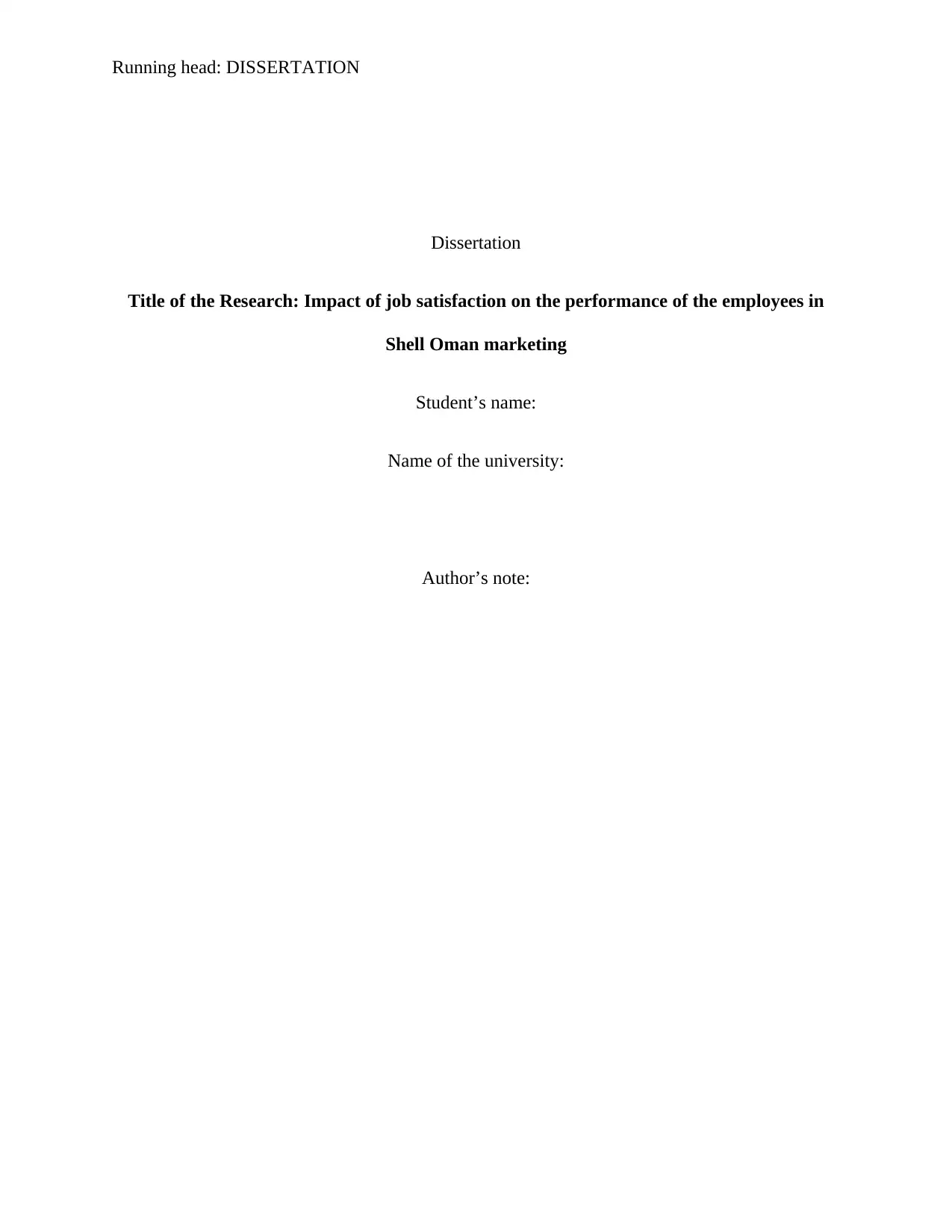
Running head: DISSERTATION
Dissertation
Title of the Research: Impact of job satisfaction on the performance of the employees in
Shell Oman marketing
Student’s name:
Name of the university:
Author’s note:
Dissertation
Title of the Research: Impact of job satisfaction on the performance of the employees in
Shell Oman marketing
Student’s name:
Name of the university:
Author’s note:
Paraphrase This Document
Need a fresh take? Get an instant paraphrase of this document with our AI Paraphraser
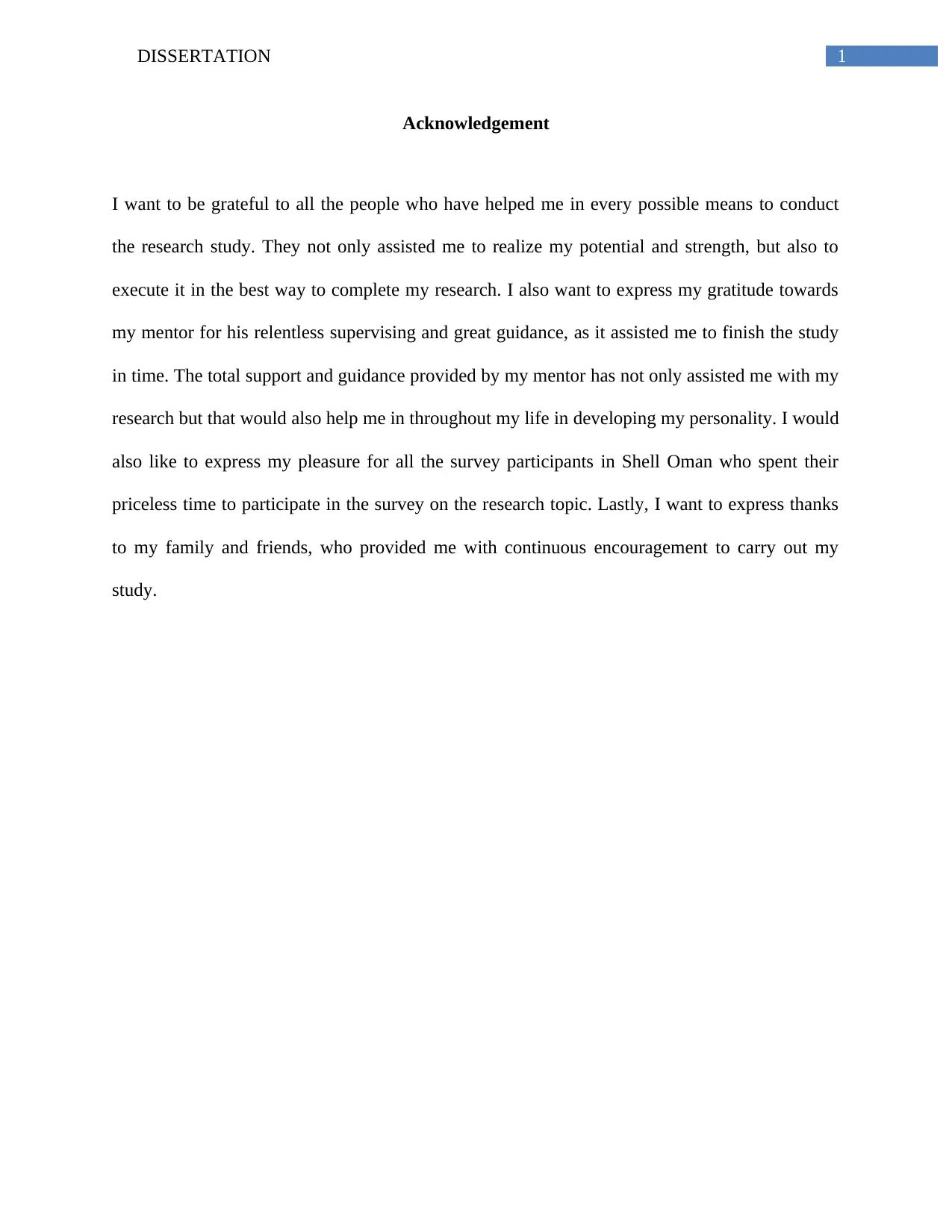
1DISSERTATION
Acknowledgement
I want to be grateful to all the people who have helped me in every possible means to conduct
the research study. They not only assisted me to realize my potential and strength, but also to
execute it in the best way to complete my research. I also want to express my gratitude towards
my mentor for his relentless supervising and great guidance, as it assisted me to finish the study
in time. The total support and guidance provided by my mentor has not only assisted me with my
research but that would also help me in throughout my life in developing my personality. I would
also like to express my pleasure for all the survey participants in Shell Oman who spent their
priceless time to participate in the survey on the research topic. Lastly, I want to express thanks
to my family and friends, who provided me with continuous encouragement to carry out my
study.
Acknowledgement
I want to be grateful to all the people who have helped me in every possible means to conduct
the research study. They not only assisted me to realize my potential and strength, but also to
execute it in the best way to complete my research. I also want to express my gratitude towards
my mentor for his relentless supervising and great guidance, as it assisted me to finish the study
in time. The total support and guidance provided by my mentor has not only assisted me with my
research but that would also help me in throughout my life in developing my personality. I would
also like to express my pleasure for all the survey participants in Shell Oman who spent their
priceless time to participate in the survey on the research topic. Lastly, I want to express thanks
to my family and friends, who provided me with continuous encouragement to carry out my
study.
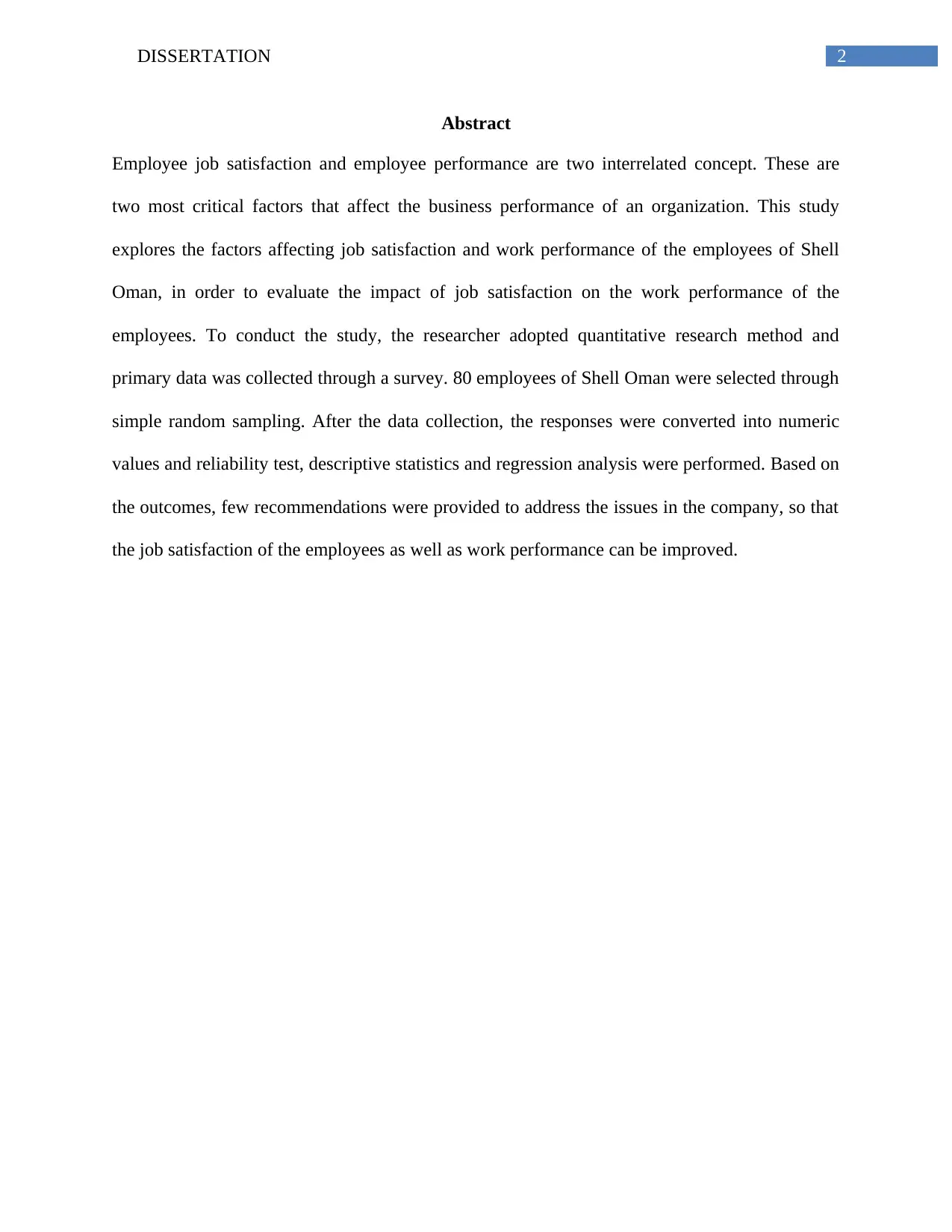
2DISSERTATION
Abstract
Employee job satisfaction and employee performance are two interrelated concept. These are
two most critical factors that affect the business performance of an organization. This study
explores the factors affecting job satisfaction and work performance of the employees of Shell
Oman, in order to evaluate the impact of job satisfaction on the work performance of the
employees. To conduct the study, the researcher adopted quantitative research method and
primary data was collected through a survey. 80 employees of Shell Oman were selected through
simple random sampling. After the data collection, the responses were converted into numeric
values and reliability test, descriptive statistics and regression analysis were performed. Based on
the outcomes, few recommendations were provided to address the issues in the company, so that
the job satisfaction of the employees as well as work performance can be improved.
Abstract
Employee job satisfaction and employee performance are two interrelated concept. These are
two most critical factors that affect the business performance of an organization. This study
explores the factors affecting job satisfaction and work performance of the employees of Shell
Oman, in order to evaluate the impact of job satisfaction on the work performance of the
employees. To conduct the study, the researcher adopted quantitative research method and
primary data was collected through a survey. 80 employees of Shell Oman were selected through
simple random sampling. After the data collection, the responses were converted into numeric
values and reliability test, descriptive statistics and regression analysis were performed. Based on
the outcomes, few recommendations were provided to address the issues in the company, so that
the job satisfaction of the employees as well as work performance can be improved.
⊘ This is a preview!⊘
Do you want full access?
Subscribe today to unlock all pages.

Trusted by 1+ million students worldwide
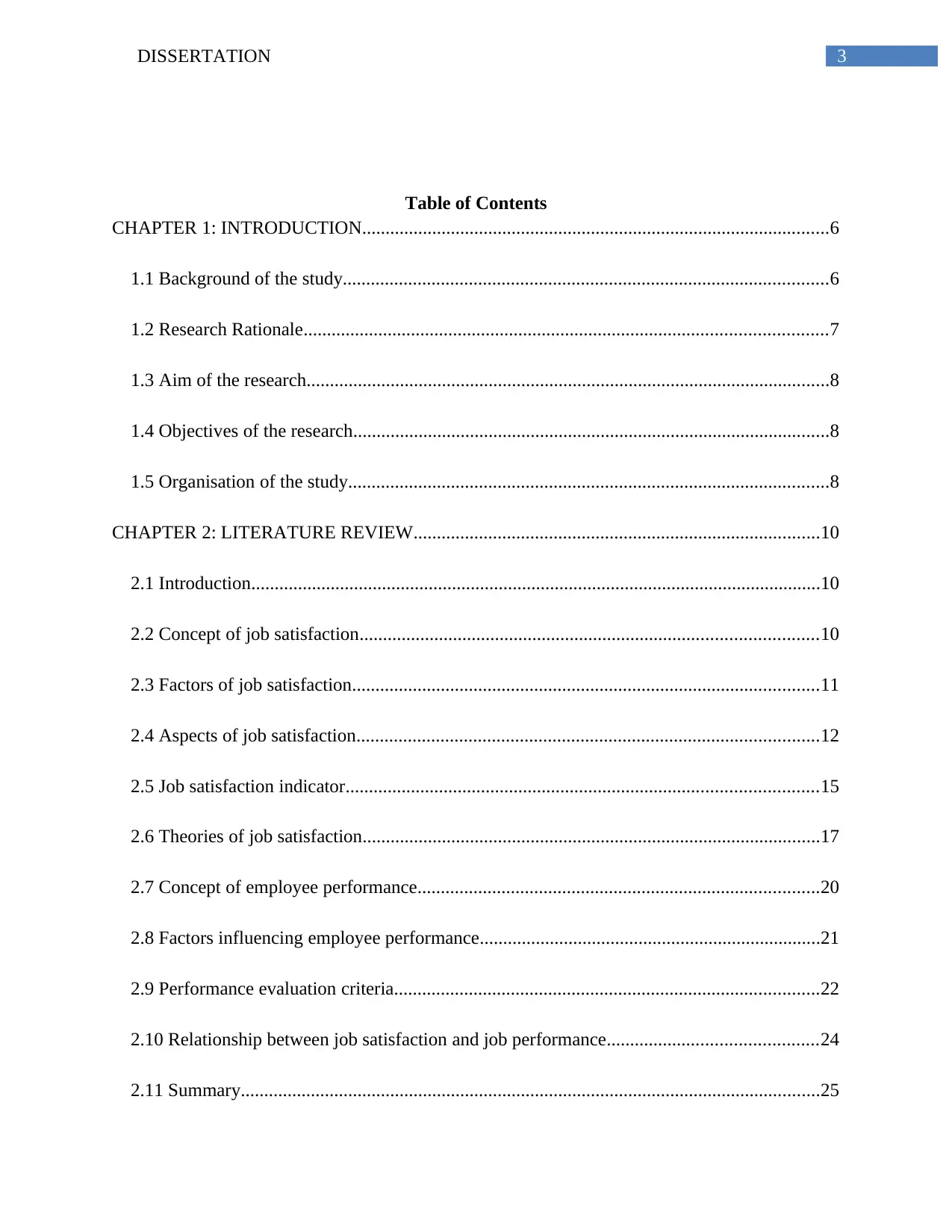
3DISSERTATION
Table of Contents
CHAPTER 1: INTRODUCTION....................................................................................................6
1.1 Background of the study........................................................................................................6
1.2 Research Rationale................................................................................................................7
1.3 Aim of the research................................................................................................................8
1.4 Objectives of the research......................................................................................................8
1.5 Organisation of the study.......................................................................................................8
CHAPTER 2: LITERATURE REVIEW.......................................................................................10
2.1 Introduction..........................................................................................................................10
2.2 Concept of job satisfaction..................................................................................................10
2.3 Factors of job satisfaction....................................................................................................11
2.4 Aspects of job satisfaction...................................................................................................12
2.5 Job satisfaction indicator.....................................................................................................15
2.6 Theories of job satisfaction..................................................................................................17
2.7 Concept of employee performance......................................................................................20
2.8 Factors influencing employee performance.........................................................................21
2.9 Performance evaluation criteria...........................................................................................22
2.10 Relationship between job satisfaction and job performance.............................................24
2.11 Summary............................................................................................................................25
Table of Contents
CHAPTER 1: INTRODUCTION....................................................................................................6
1.1 Background of the study........................................................................................................6
1.2 Research Rationale................................................................................................................7
1.3 Aim of the research................................................................................................................8
1.4 Objectives of the research......................................................................................................8
1.5 Organisation of the study.......................................................................................................8
CHAPTER 2: LITERATURE REVIEW.......................................................................................10
2.1 Introduction..........................................................................................................................10
2.2 Concept of job satisfaction..................................................................................................10
2.3 Factors of job satisfaction....................................................................................................11
2.4 Aspects of job satisfaction...................................................................................................12
2.5 Job satisfaction indicator.....................................................................................................15
2.6 Theories of job satisfaction..................................................................................................17
2.7 Concept of employee performance......................................................................................20
2.8 Factors influencing employee performance.........................................................................21
2.9 Performance evaluation criteria...........................................................................................22
2.10 Relationship between job satisfaction and job performance.............................................24
2.11 Summary............................................................................................................................25
Paraphrase This Document
Need a fresh take? Get an instant paraphrase of this document with our AI Paraphraser
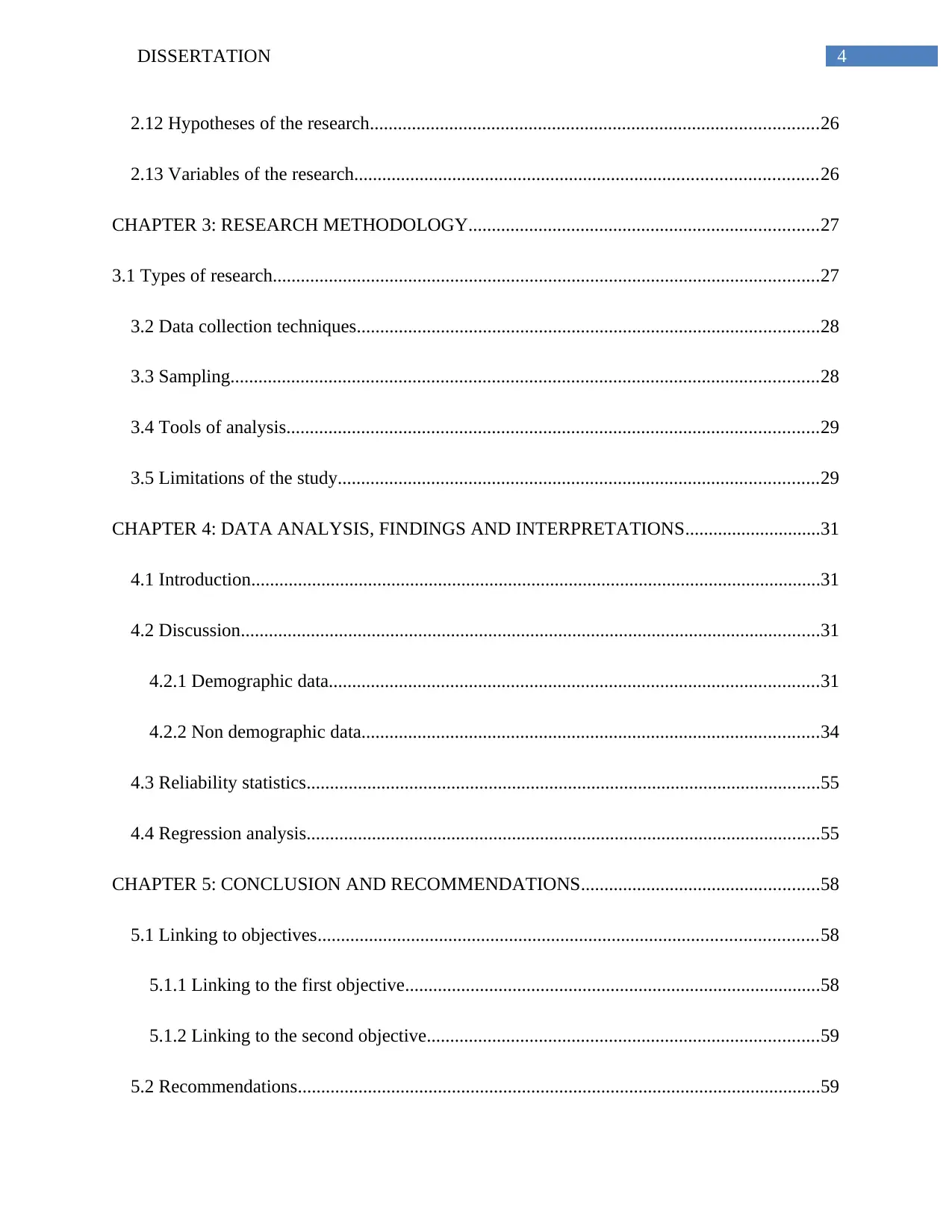
4DISSERTATION
2.12 Hypotheses of the research................................................................................................26
2.13 Variables of the research...................................................................................................26
CHAPTER 3: RESEARCH METHODOLOGY...........................................................................27
3.1 Types of research.....................................................................................................................27
3.2 Data collection techniques...................................................................................................28
3.3 Sampling..............................................................................................................................28
3.4 Tools of analysis..................................................................................................................29
3.5 Limitations of the study.......................................................................................................29
CHAPTER 4: DATA ANALYSIS, FINDINGS AND INTERPRETATIONS.............................31
4.1 Introduction..........................................................................................................................31
4.2 Discussion............................................................................................................................31
4.2.1 Demographic data.........................................................................................................31
4.2.2 Non demographic data..................................................................................................34
4.3 Reliability statistics..............................................................................................................55
4.4 Regression analysis..............................................................................................................55
CHAPTER 5: CONCLUSION AND RECOMMENDATIONS...................................................58
5.1 Linking to objectives...........................................................................................................58
5.1.1 Linking to the first objective.........................................................................................58
5.1.2 Linking to the second objective....................................................................................59
5.2 Recommendations................................................................................................................59
2.12 Hypotheses of the research................................................................................................26
2.13 Variables of the research...................................................................................................26
CHAPTER 3: RESEARCH METHODOLOGY...........................................................................27
3.1 Types of research.....................................................................................................................27
3.2 Data collection techniques...................................................................................................28
3.3 Sampling..............................................................................................................................28
3.4 Tools of analysis..................................................................................................................29
3.5 Limitations of the study.......................................................................................................29
CHAPTER 4: DATA ANALYSIS, FINDINGS AND INTERPRETATIONS.............................31
4.1 Introduction..........................................................................................................................31
4.2 Discussion............................................................................................................................31
4.2.1 Demographic data.........................................................................................................31
4.2.2 Non demographic data..................................................................................................34
4.3 Reliability statistics..............................................................................................................55
4.4 Regression analysis..............................................................................................................55
CHAPTER 5: CONCLUSION AND RECOMMENDATIONS...................................................58
5.1 Linking to objectives...........................................................................................................58
5.1.1 Linking to the first objective.........................................................................................58
5.1.2 Linking to the second objective....................................................................................59
5.2 Recommendations................................................................................................................59
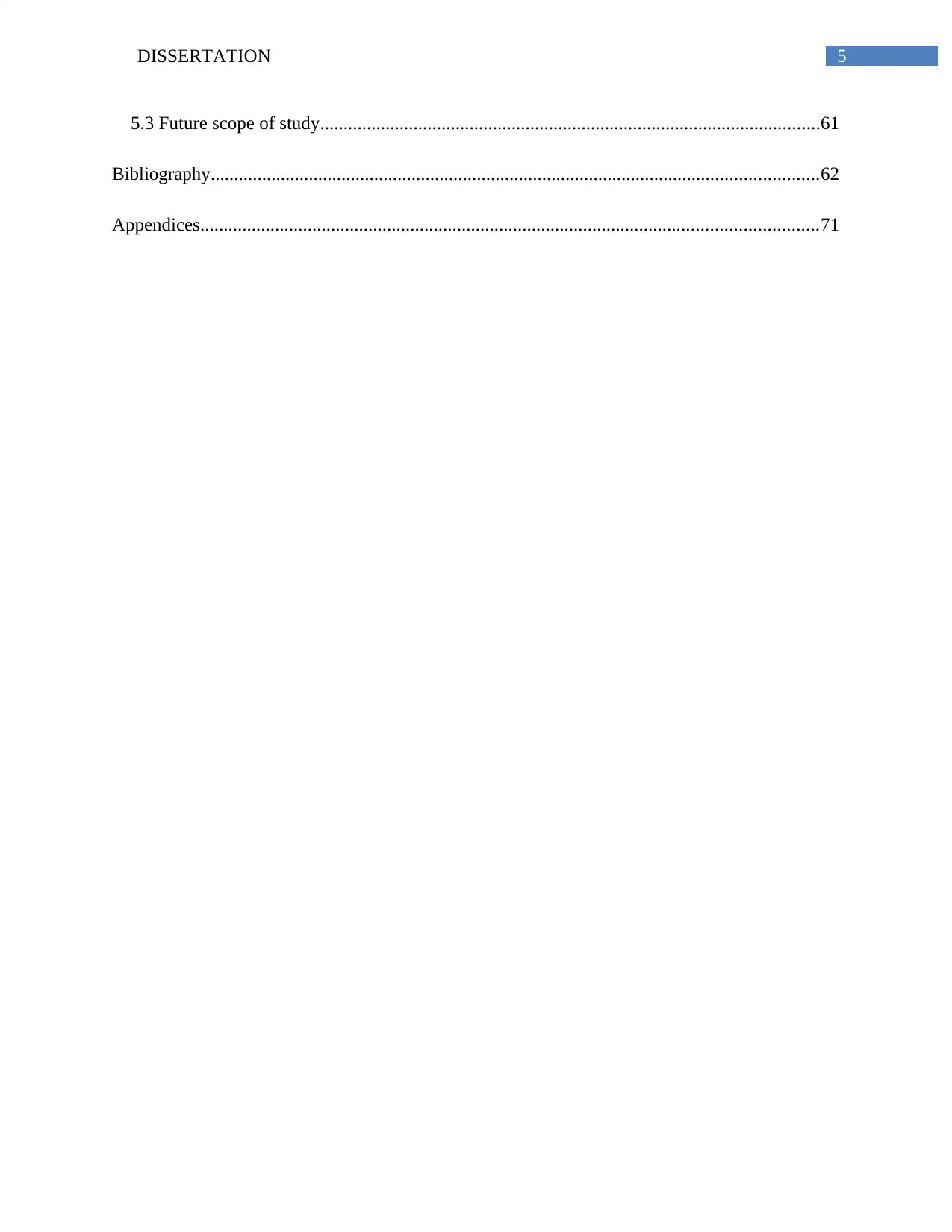
5DISSERTATION
5.3 Future scope of study...........................................................................................................61
Bibliography..................................................................................................................................62
Appendices....................................................................................................................................71
5.3 Future scope of study...........................................................................................................61
Bibliography..................................................................................................................................62
Appendices....................................................................................................................................71
⊘ This is a preview!⊘
Do you want full access?
Subscribe today to unlock all pages.

Trusted by 1+ million students worldwide
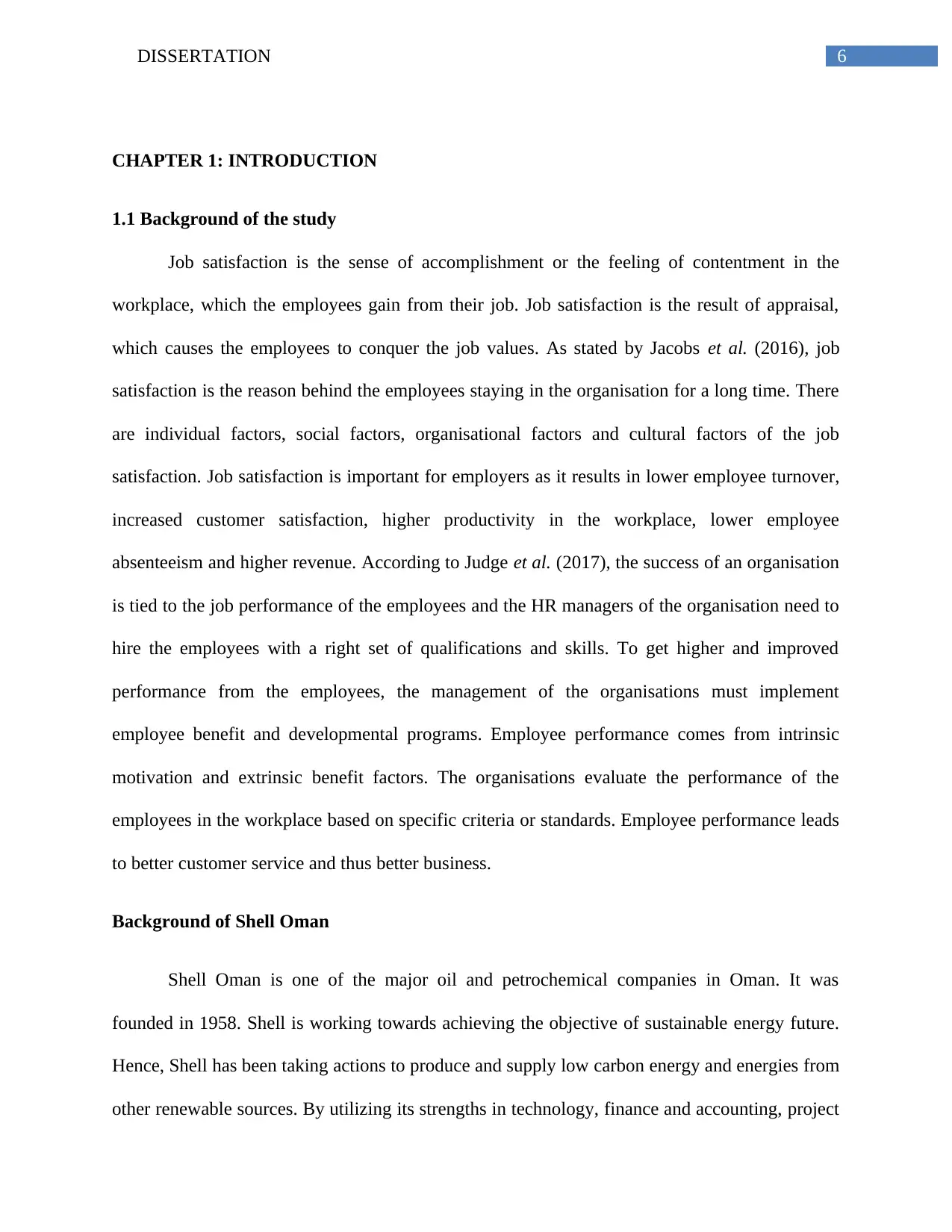
6DISSERTATION
CHAPTER 1: INTRODUCTION
1.1 Background of the study
Job satisfaction is the sense of accomplishment or the feeling of contentment in the
workplace, which the employees gain from their job. Job satisfaction is the result of appraisal,
which causes the employees to conquer the job values. As stated by Jacobs et al. (2016), job
satisfaction is the reason behind the employees staying in the organisation for a long time. There
are individual factors, social factors, organisational factors and cultural factors of the job
satisfaction. Job satisfaction is important for employers as it results in lower employee turnover,
increased customer satisfaction, higher productivity in the workplace, lower employee
absenteeism and higher revenue. According to Judge et al. (2017), the success of an organisation
is tied to the job performance of the employees and the HR managers of the organisation need to
hire the employees with a right set of qualifications and skills. To get higher and improved
performance from the employees, the management of the organisations must implement
employee benefit and developmental programs. Employee performance comes from intrinsic
motivation and extrinsic benefit factors. The organisations evaluate the performance of the
employees in the workplace based on specific criteria or standards. Employee performance leads
to better customer service and thus better business.
Background of Shell Oman
Shell Oman is one of the major oil and petrochemical companies in Oman. It was
founded in 1958. Shell is working towards achieving the objective of sustainable energy future.
Hence, Shell has been taking actions to produce and supply low carbon energy and energies from
other renewable sources. By utilizing its strengths in technology, finance and accounting, project
CHAPTER 1: INTRODUCTION
1.1 Background of the study
Job satisfaction is the sense of accomplishment or the feeling of contentment in the
workplace, which the employees gain from their job. Job satisfaction is the result of appraisal,
which causes the employees to conquer the job values. As stated by Jacobs et al. (2016), job
satisfaction is the reason behind the employees staying in the organisation for a long time. There
are individual factors, social factors, organisational factors and cultural factors of the job
satisfaction. Job satisfaction is important for employers as it results in lower employee turnover,
increased customer satisfaction, higher productivity in the workplace, lower employee
absenteeism and higher revenue. According to Judge et al. (2017), the success of an organisation
is tied to the job performance of the employees and the HR managers of the organisation need to
hire the employees with a right set of qualifications and skills. To get higher and improved
performance from the employees, the management of the organisations must implement
employee benefit and developmental programs. Employee performance comes from intrinsic
motivation and extrinsic benefit factors. The organisations evaluate the performance of the
employees in the workplace based on specific criteria or standards. Employee performance leads
to better customer service and thus better business.
Background of Shell Oman
Shell Oman is one of the major oil and petrochemical companies in Oman. It was
founded in 1958. Shell is working towards achieving the objective of sustainable energy future.
Hence, Shell has been taking actions to produce and supply low carbon energy and energies from
other renewable sources. By utilizing its strengths in technology, finance and accounting, project
Paraphrase This Document
Need a fresh take? Get an instant paraphrase of this document with our AI Paraphraser
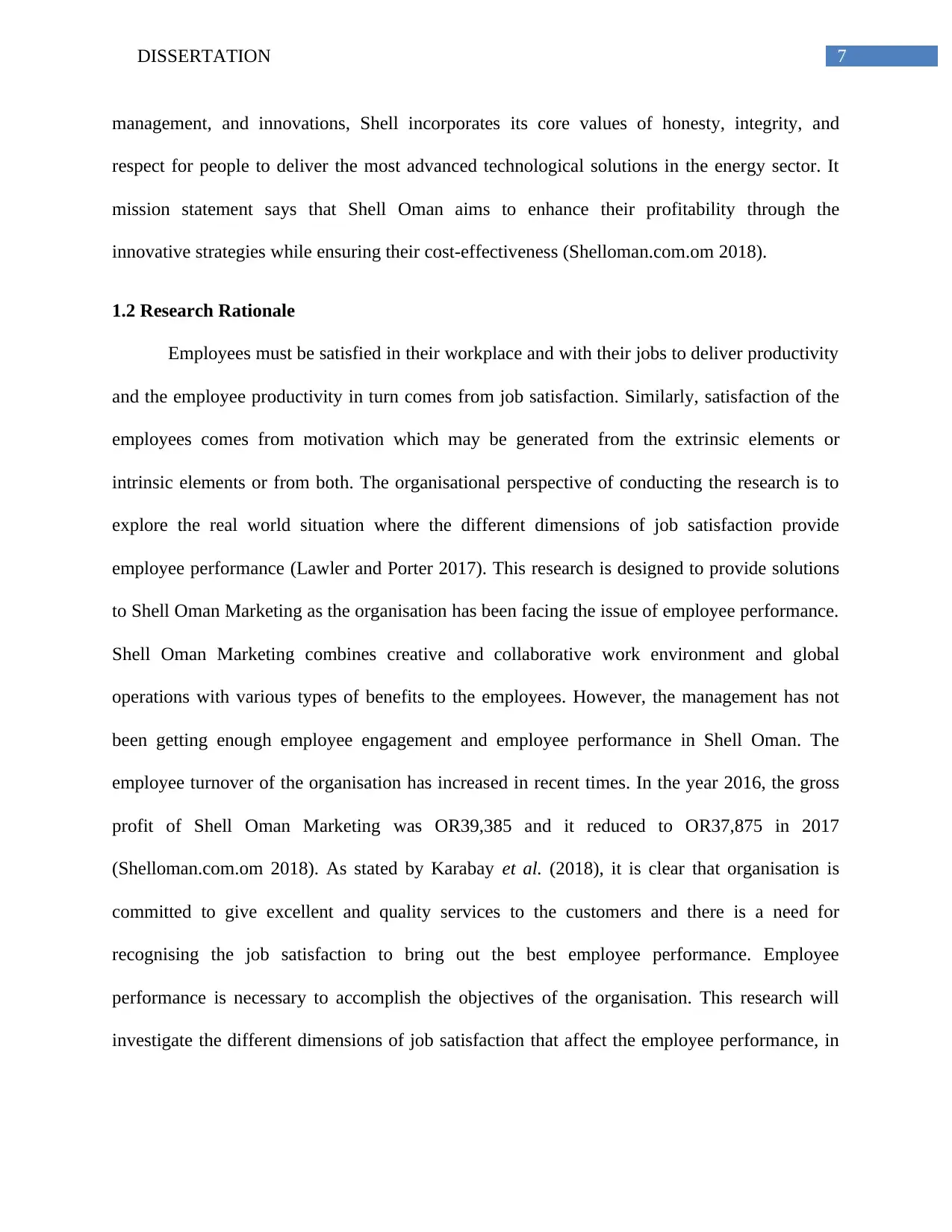
7DISSERTATION
management, and innovations, Shell incorporates its core values of honesty, integrity, and
respect for people to deliver the most advanced technological solutions in the energy sector. It
mission statement says that Shell Oman aims to enhance their profitability through the
innovative strategies while ensuring their cost-effectiveness (Shelloman.com.om 2018).
1.2 Research Rationale
Employees must be satisfied in their workplace and with their jobs to deliver productivity
and the employee productivity in turn comes from job satisfaction. Similarly, satisfaction of the
employees comes from motivation which may be generated from the extrinsic elements or
intrinsic elements or from both. The organisational perspective of conducting the research is to
explore the real world situation where the different dimensions of job satisfaction provide
employee performance (Lawler and Porter 2017). This research is designed to provide solutions
to Shell Oman Marketing as the organisation has been facing the issue of employee performance.
Shell Oman Marketing combines creative and collaborative work environment and global
operations with various types of benefits to the employees. However, the management has not
been getting enough employee engagement and employee performance in Shell Oman. The
employee turnover of the organisation has increased in recent times. In the year 2016, the gross
profit of Shell Oman Marketing was OR39,385 and it reduced to OR37,875 in 2017
(Shelloman.com.om 2018). As stated by Karabay et al. (2018), it is clear that organisation is
committed to give excellent and quality services to the customers and there is a need for
recognising the job satisfaction to bring out the best employee performance. Employee
performance is necessary to accomplish the objectives of the organisation. This research will
investigate the different dimensions of job satisfaction that affect the employee performance, in
management, and innovations, Shell incorporates its core values of honesty, integrity, and
respect for people to deliver the most advanced technological solutions in the energy sector. It
mission statement says that Shell Oman aims to enhance their profitability through the
innovative strategies while ensuring their cost-effectiveness (Shelloman.com.om 2018).
1.2 Research Rationale
Employees must be satisfied in their workplace and with their jobs to deliver productivity
and the employee productivity in turn comes from job satisfaction. Similarly, satisfaction of the
employees comes from motivation which may be generated from the extrinsic elements or
intrinsic elements or from both. The organisational perspective of conducting the research is to
explore the real world situation where the different dimensions of job satisfaction provide
employee performance (Lawler and Porter 2017). This research is designed to provide solutions
to Shell Oman Marketing as the organisation has been facing the issue of employee performance.
Shell Oman Marketing combines creative and collaborative work environment and global
operations with various types of benefits to the employees. However, the management has not
been getting enough employee engagement and employee performance in Shell Oman. The
employee turnover of the organisation has increased in recent times. In the year 2016, the gross
profit of Shell Oman Marketing was OR39,385 and it reduced to OR37,875 in 2017
(Shelloman.com.om 2018). As stated by Karabay et al. (2018), it is clear that organisation is
committed to give excellent and quality services to the customers and there is a need for
recognising the job satisfaction to bring out the best employee performance. Employee
performance is necessary to accomplish the objectives of the organisation. This research will
investigate the different dimensions of job satisfaction that affect the employee performance, in
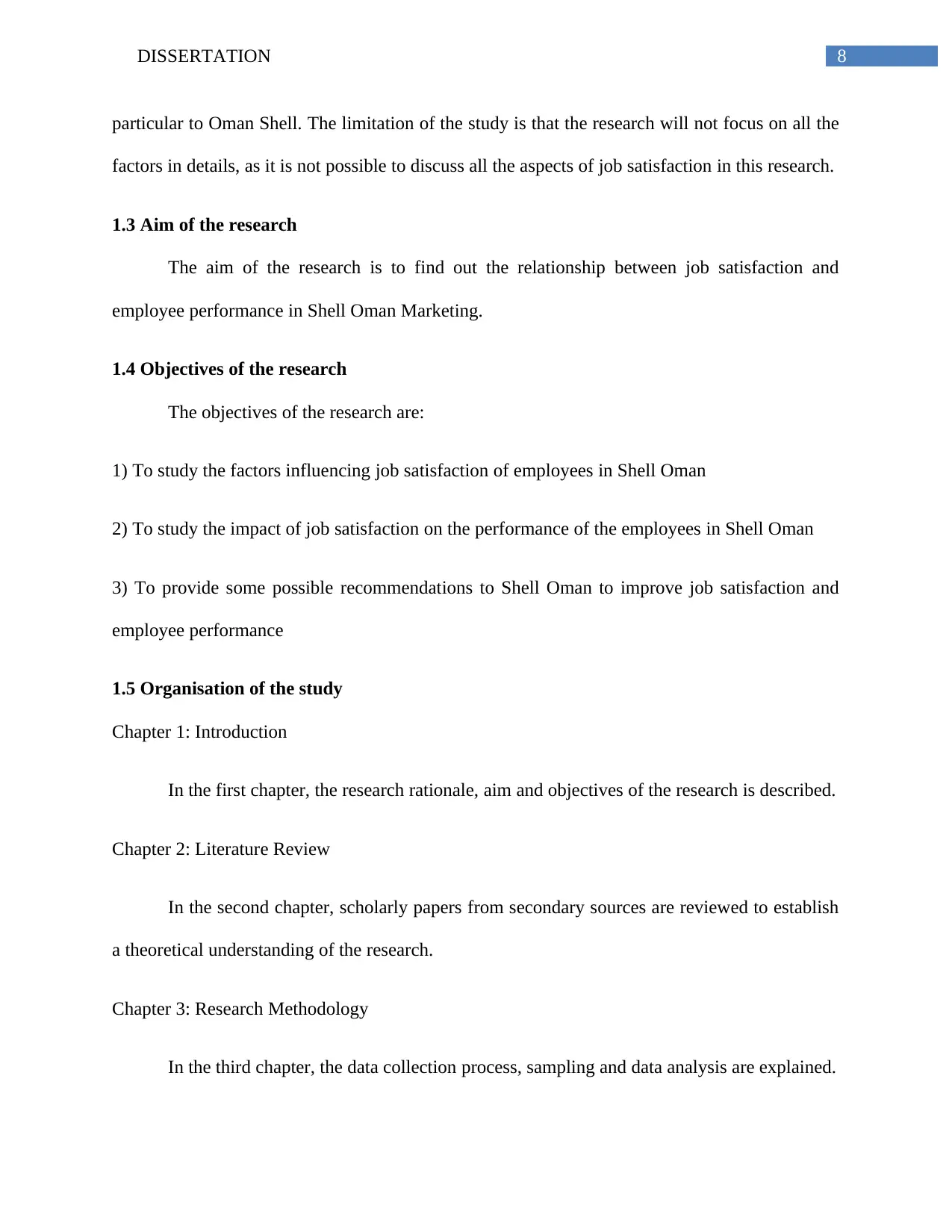
8DISSERTATION
particular to Oman Shell. The limitation of the study is that the research will not focus on all the
factors in details, as it is not possible to discuss all the aspects of job satisfaction in this research.
1.3 Aim of the research
The aim of the research is to find out the relationship between job satisfaction and
employee performance in Shell Oman Marketing.
1.4 Objectives of the research
The objectives of the research are:
1) To study the factors influencing job satisfaction of employees in Shell Oman
2) To study the impact of job satisfaction on the performance of the employees in Shell Oman
3) To provide some possible recommendations to Shell Oman to improve job satisfaction and
employee performance
1.5 Organisation of the study
Chapter 1: Introduction
In the first chapter, the research rationale, aim and objectives of the research is described.
Chapter 2: Literature Review
In the second chapter, scholarly papers from secondary sources are reviewed to establish
a theoretical understanding of the research.
Chapter 3: Research Methodology
In the third chapter, the data collection process, sampling and data analysis are explained.
particular to Oman Shell. The limitation of the study is that the research will not focus on all the
factors in details, as it is not possible to discuss all the aspects of job satisfaction in this research.
1.3 Aim of the research
The aim of the research is to find out the relationship between job satisfaction and
employee performance in Shell Oman Marketing.
1.4 Objectives of the research
The objectives of the research are:
1) To study the factors influencing job satisfaction of employees in Shell Oman
2) To study the impact of job satisfaction on the performance of the employees in Shell Oman
3) To provide some possible recommendations to Shell Oman to improve job satisfaction and
employee performance
1.5 Organisation of the study
Chapter 1: Introduction
In the first chapter, the research rationale, aim and objectives of the research is described.
Chapter 2: Literature Review
In the second chapter, scholarly papers from secondary sources are reviewed to establish
a theoretical understanding of the research.
Chapter 3: Research Methodology
In the third chapter, the data collection process, sampling and data analysis are explained.
⊘ This is a preview!⊘
Do you want full access?
Subscribe today to unlock all pages.

Trusted by 1+ million students worldwide
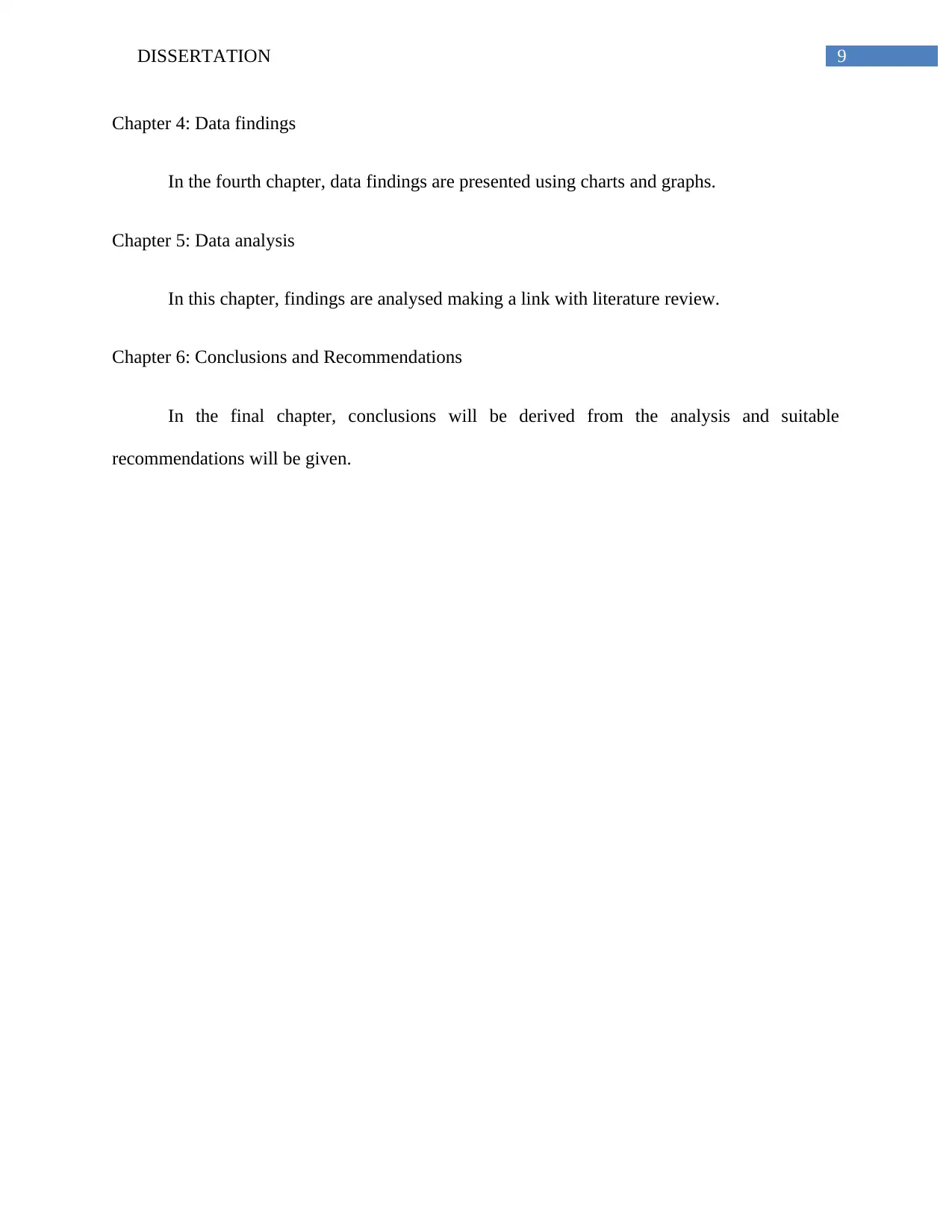
9DISSERTATION
Chapter 4: Data findings
In the fourth chapter, data findings are presented using charts and graphs.
Chapter 5: Data analysis
In this chapter, findings are analysed making a link with literature review.
Chapter 6: Conclusions and Recommendations
In the final chapter, conclusions will be derived from the analysis and suitable
recommendations will be given.
Chapter 4: Data findings
In the fourth chapter, data findings are presented using charts and graphs.
Chapter 5: Data analysis
In this chapter, findings are analysed making a link with literature review.
Chapter 6: Conclusions and Recommendations
In the final chapter, conclusions will be derived from the analysis and suitable
recommendations will be given.
Paraphrase This Document
Need a fresh take? Get an instant paraphrase of this document with our AI Paraphraser
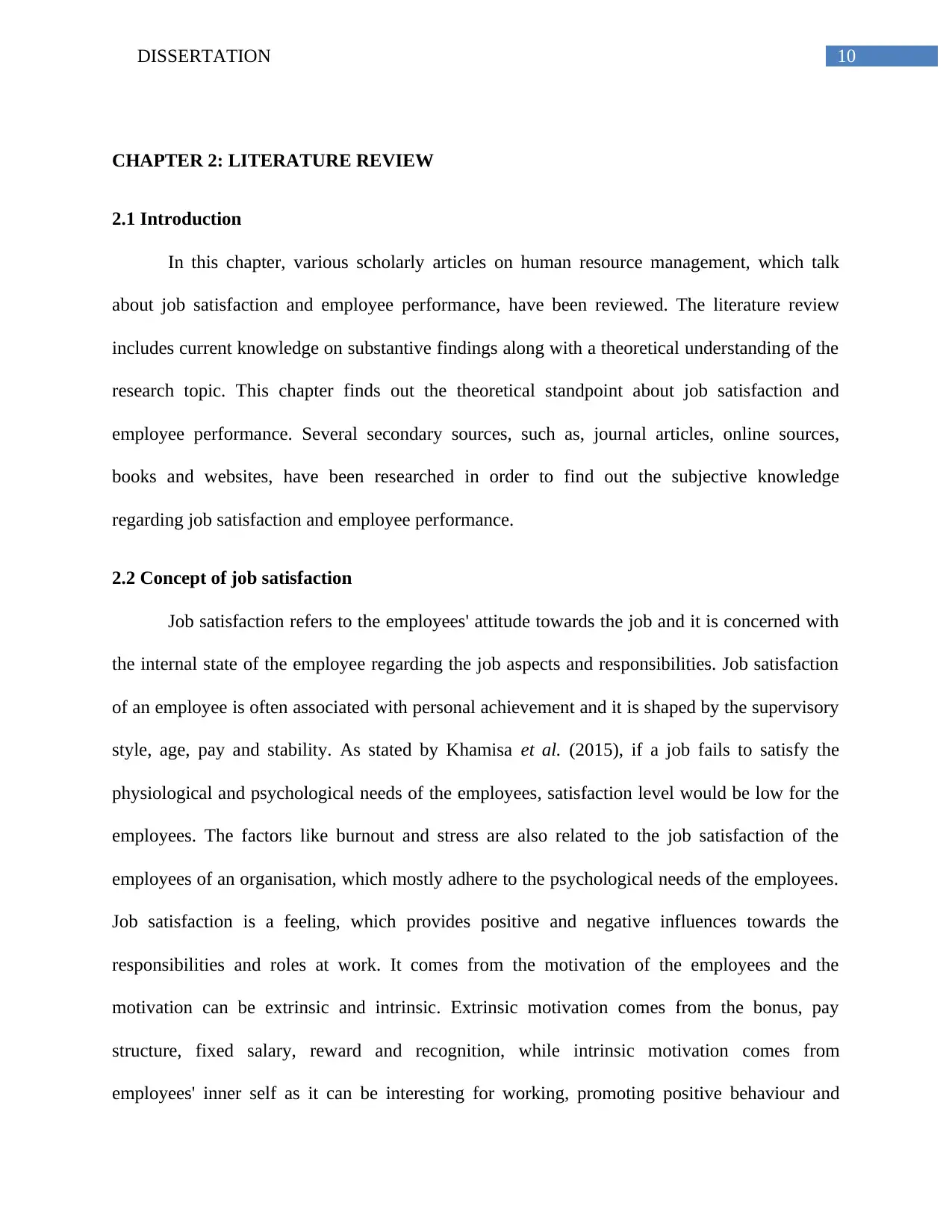
10DISSERTATION
CHAPTER 2: LITERATURE REVIEW
2.1 Introduction
In this chapter, various scholarly articles on human resource management, which talk
about job satisfaction and employee performance, have been reviewed. The literature review
includes current knowledge on substantive findings along with a theoretical understanding of the
research topic. This chapter finds out the theoretical standpoint about job satisfaction and
employee performance. Several secondary sources, such as, journal articles, online sources,
books and websites, have been researched in order to find out the subjective knowledge
regarding job satisfaction and employee performance.
2.2 Concept of job satisfaction
Job satisfaction refers to the employees' attitude towards the job and it is concerned with
the internal state of the employee regarding the job aspects and responsibilities. Job satisfaction
of an employee is often associated with personal achievement and it is shaped by the supervisory
style, age, pay and stability. As stated by Khamisa et al. (2015), if a job fails to satisfy the
physiological and psychological needs of the employees, satisfaction level would be low for the
employees. The factors like burnout and stress are also related to the job satisfaction of the
employees of an organisation, which mostly adhere to the psychological needs of the employees.
Job satisfaction is a feeling, which provides positive and negative influences towards the
responsibilities and roles at work. It comes from the motivation of the employees and the
motivation can be extrinsic and intrinsic. Extrinsic motivation comes from the bonus, pay
structure, fixed salary, reward and recognition, while intrinsic motivation comes from
employees' inner self as it can be interesting for working, promoting positive behaviour and
CHAPTER 2: LITERATURE REVIEW
2.1 Introduction
In this chapter, various scholarly articles on human resource management, which talk
about job satisfaction and employee performance, have been reviewed. The literature review
includes current knowledge on substantive findings along with a theoretical understanding of the
research topic. This chapter finds out the theoretical standpoint about job satisfaction and
employee performance. Several secondary sources, such as, journal articles, online sources,
books and websites, have been researched in order to find out the subjective knowledge
regarding job satisfaction and employee performance.
2.2 Concept of job satisfaction
Job satisfaction refers to the employees' attitude towards the job and it is concerned with
the internal state of the employee regarding the job aspects and responsibilities. Job satisfaction
of an employee is often associated with personal achievement and it is shaped by the supervisory
style, age, pay and stability. As stated by Khamisa et al. (2015), if a job fails to satisfy the
physiological and psychological needs of the employees, satisfaction level would be low for the
employees. The factors like burnout and stress are also related to the job satisfaction of the
employees of an organisation, which mostly adhere to the psychological needs of the employees.
Job satisfaction is a feeling, which provides positive and negative influences towards the
responsibilities and roles at work. It comes from the motivation of the employees and the
motivation can be extrinsic and intrinsic. Extrinsic motivation comes from the bonus, pay
structure, fixed salary, reward and recognition, while intrinsic motivation comes from
employees' inner self as it can be interesting for working, promoting positive behaviour and
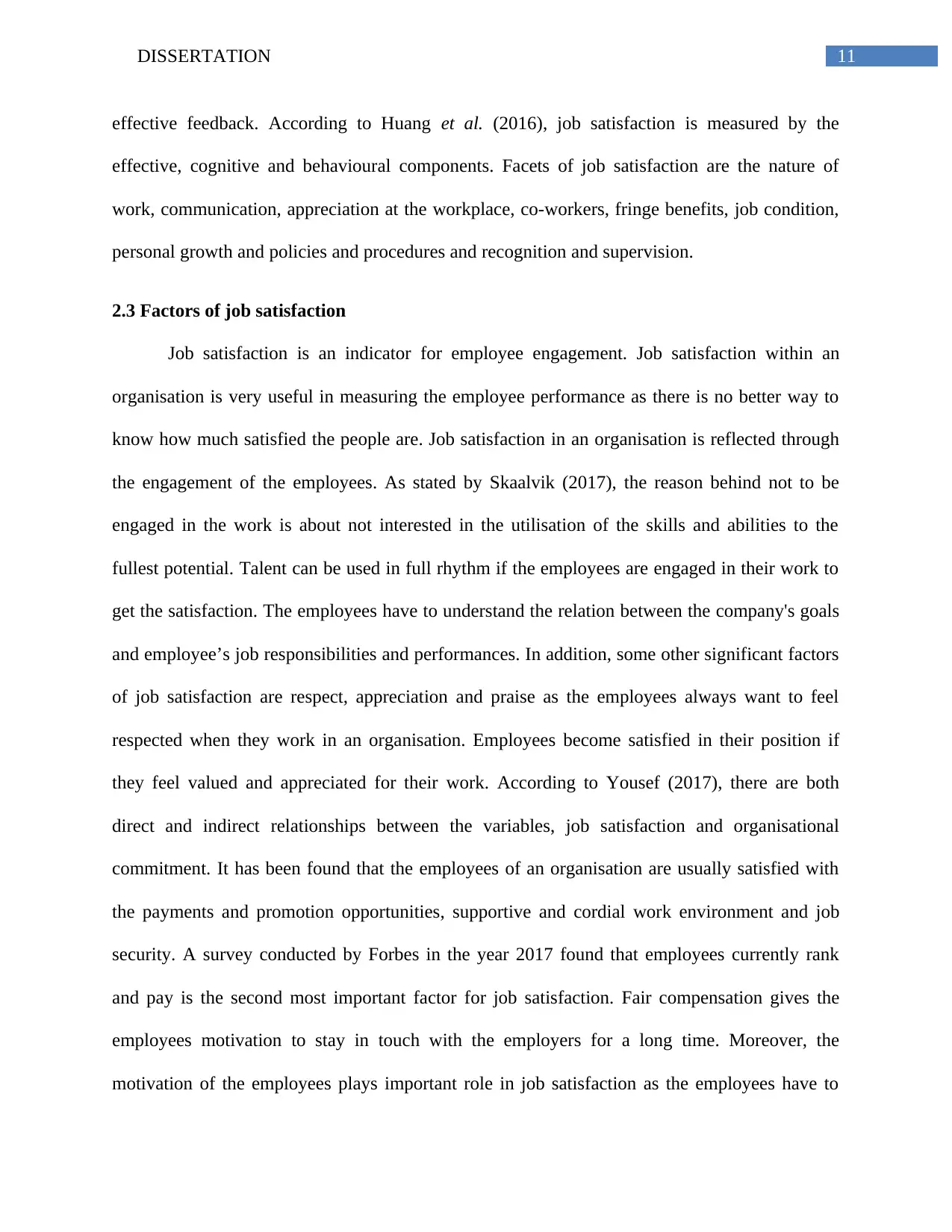
11DISSERTATION
effective feedback. According to Huang et al. (2016), job satisfaction is measured by the
effective, cognitive and behavioural components. Facets of job satisfaction are the nature of
work, communication, appreciation at the workplace, co-workers, fringe benefits, job condition,
personal growth and policies and procedures and recognition and supervision.
2.3 Factors of job satisfaction
Job satisfaction is an indicator for employee engagement. Job satisfaction within an
organisation is very useful in measuring the employee performance as there is no better way to
know how much satisfied the people are. Job satisfaction in an organisation is reflected through
the engagement of the employees. As stated by Skaalvik (2017), the reason behind not to be
engaged in the work is about not interested in the utilisation of the skills and abilities to the
fullest potential. Talent can be used in full rhythm if the employees are engaged in their work to
get the satisfaction. The employees have to understand the relation between the company's goals
and employee’s job responsibilities and performances. In addition, some other significant factors
of job satisfaction are respect, appreciation and praise as the employees always want to feel
respected when they work in an organisation. Employees become satisfied in their position if
they feel valued and appreciated for their work. According to Yousef (2017), there are both
direct and indirect relationships between the variables, job satisfaction and organisational
commitment. It has been found that the employees of an organisation are usually satisfied with
the payments and promotion opportunities, supportive and cordial work environment and job
security. A survey conducted by Forbes in the year 2017 found that employees currently rank
and pay is the second most important factor for job satisfaction. Fair compensation gives the
employees motivation to stay in touch with the employers for a long time. Moreover, the
motivation of the employees plays important role in job satisfaction as the employees have to
effective feedback. According to Huang et al. (2016), job satisfaction is measured by the
effective, cognitive and behavioural components. Facets of job satisfaction are the nature of
work, communication, appreciation at the workplace, co-workers, fringe benefits, job condition,
personal growth and policies and procedures and recognition and supervision.
2.3 Factors of job satisfaction
Job satisfaction is an indicator for employee engagement. Job satisfaction within an
organisation is very useful in measuring the employee performance as there is no better way to
know how much satisfied the people are. Job satisfaction in an organisation is reflected through
the engagement of the employees. As stated by Skaalvik (2017), the reason behind not to be
engaged in the work is about not interested in the utilisation of the skills and abilities to the
fullest potential. Talent can be used in full rhythm if the employees are engaged in their work to
get the satisfaction. The employees have to understand the relation between the company's goals
and employee’s job responsibilities and performances. In addition, some other significant factors
of job satisfaction are respect, appreciation and praise as the employees always want to feel
respected when they work in an organisation. Employees become satisfied in their position if
they feel valued and appreciated for their work. According to Yousef (2017), there are both
direct and indirect relationships between the variables, job satisfaction and organisational
commitment. It has been found that the employees of an organisation are usually satisfied with
the payments and promotion opportunities, supportive and cordial work environment and job
security. A survey conducted by Forbes in the year 2017 found that employees currently rank
and pay is the second most important factor for job satisfaction. Fair compensation gives the
employees motivation to stay in touch with the employers for a long time. Moreover, the
motivation of the employees plays important role in job satisfaction as the employees have to
⊘ This is a preview!⊘
Do you want full access?
Subscribe today to unlock all pages.

Trusted by 1+ million students worldwide
1 out of 84
Related Documents
Your All-in-One AI-Powered Toolkit for Academic Success.
+13062052269
info@desklib.com
Available 24*7 on WhatsApp / Email
![[object Object]](/_next/static/media/star-bottom.7253800d.svg)
Unlock your academic potential
Copyright © 2020–2025 A2Z Services. All Rights Reserved. Developed and managed by ZUCOL.





